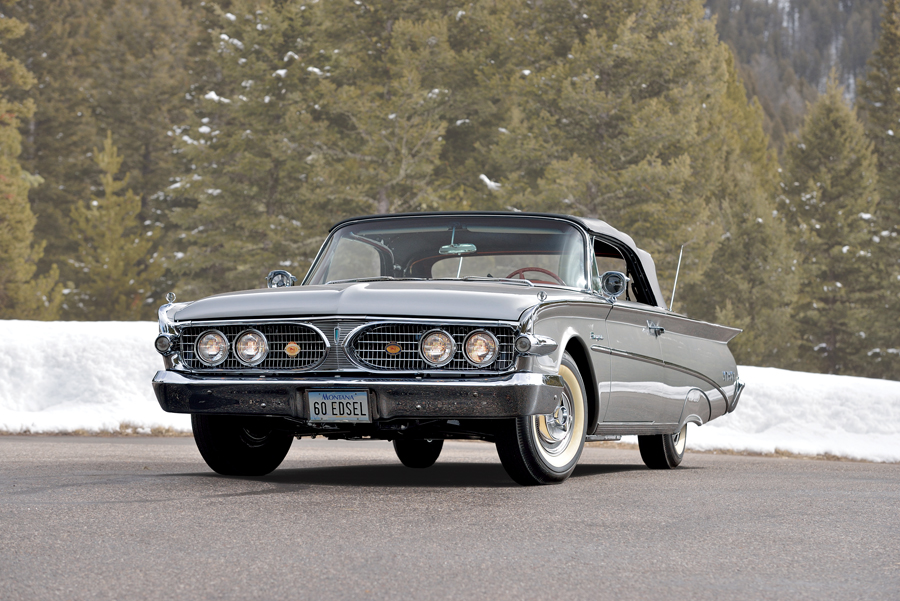SCM Analysis
Detailing
| Vehicle: | 1960 Edsel Ranger Convertible |
| Years Produced: | 1960 |
| Number Produced: | 76 convertibles |
| Original List Price: | $4,162 |
| SCM Valuation: | $80,250 |
| Chassis Number Location: | Left front door pillar and frame rail |
| Engine Number Location: | Side of block above oil filter |
| Club Info: | International Edsel Club |
| Website: | http://www.internationaledsel.com |
| Alternatives: | 1960 Mercury Monterey convertible, 1960 Pontiac Bonneville convertible, 1960 Oldsmobile Cutlass convertible |
| Investment Grade: | C |
This car, Lot F178, sold for $110,000, including buyer’s premium, at Mecum’s auction in Indianapolis, IN, on May 15–20, 2018.
The Edsel has long been fodder for late-night comedians’ material; however, in 1960 Ford did get it right. Well, at least they were closer to getting it right. But one month after introduction, Ford pulled the plug, incurring an approximate $350 million loss.
The reasons for Edsel’s failure have long been debated. Poor styling and quality, a failing economy and lack of market research were several causes. In short, it was the “wrong car at the wrong time,” and was “designed by committee.” But to understand the environment and corporate culture that led to the Edsel and its failure, we need to take a step back in time.
Ford in trouble
At the conclusion of World War II, Ford was in dire financial straits. They were hemorrhaging money, losing millions each month. They had no financial procedures in place to allow them to understand their position. They even lost money on cost-plus government contracts during the war.
Young Henry Ford II had recently taken control of Ford and knew he needed help. When “Tex” Thornton offered the services of 10 management-efficiency experts who had worked together in the Army Air Corps, Ford quickly hired the “Whiz Kids.”
They did, in fact, turn Ford around and implemented sound financial procedures, but they were not “car guys” and looked strictly at the numbers. If a $4 part improved reliability but there was no direct cost benefit, the “bean counters” would not approve it. As a result, quality suffered.
The Edsel
The team recognized that they were at a product disadvantage compared to General Motors, so they developed the experimental “E-Car” to fit between their existing product offerings. The first indication of trouble was their inability to select a name for the car. Thousands were proposed, and Edsel, Henry Ford’s son’s first name, was selected. Even Henry Ford II objected.
After an extensive advertising campaign that promised “More You Ideas” but never showed the car, the Edsel was introduced on “E-Day”: September 4, 1957. The reaction was underwhelming. Eighteen models that were based on both Ford and Mercury chassis were to fill the two missing market segments between Ford and Mercury and below Lincoln. They had overlapping pricing with no clear product definition. It was not the “New Kind of Car” promised — most thought of it as simply a warmed-over Ford.
The horse-collar grille was not well received and overall quality was abhorrent. The rolling-dome speedometer and self-adjusting brakes were unique, but the Teletouch transmission, in the center of the steering hub, was problematic. Only 63,110 were produced in the U.S.
The Mercury-based Edsels were discontinued for 1959 and production continued to slide, with only 44,891 U.S.-produced Edsels leaving the showrooms.
Final try
Ford gave the car one last chance and redesigned the Edsel on the same body style as the 1960 Ford Fairlane, replacing the horse-collar grille with one reminiscent of the 1959 Pontiac Bonneville. It had distinctive side trim and vertical taillights that rose above the rear deck. Advertised as “New-Nifty-Thrifty,” it showed promise but in reality never had a chance. The Edsel was only offered as a Ranger or Villager station wagon. Only 76 convertibles were produced.
While the Edsel Ranger is frequently cloned, there is no doubt regarding the convertible that was sold by Mecum. A copy of the invoice indicates that the original $3,000 list price grew to $4,162 with the addition of every conceivable power option, Level-Temp air conditioning, and most every other option checked on the order sheet.
Powered by the optional Express V8 and finished in Cloud Silver Metallic, it had been restored to perfection, as documented by the bevy of trophies and awards — including an AACA National Senior badge.
The same factors that caused buyers to shun the Edsel in the era are the attributes that attract collectors to the Edsel today. This 1960 Edsel Ranger stands as the best of the bunch, and with only 25 original convertible examples thought to still exist, this is the one to own. I’ll call it fairly bought at this price, as it’ll be hard to duplicate the opportunity to buy one at all, let alone one done to this level. Well bought and sold.
(Introductory description courtesy of Mecum Auctions.)
